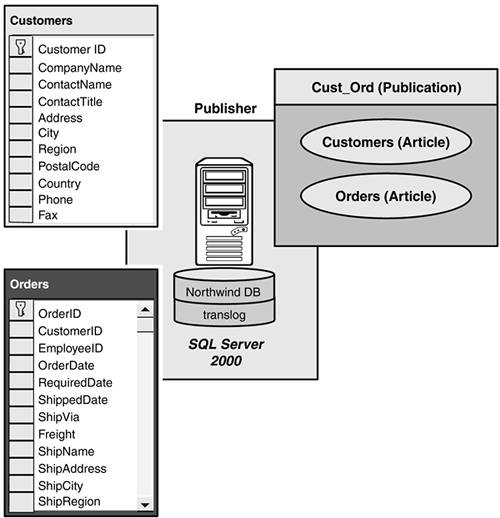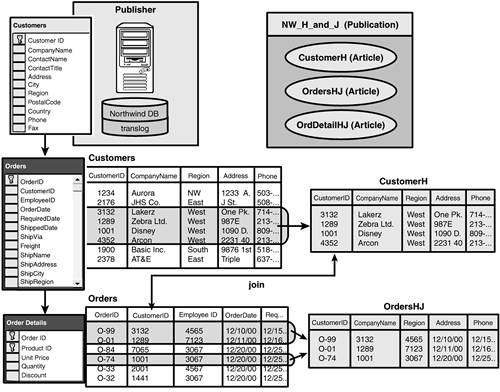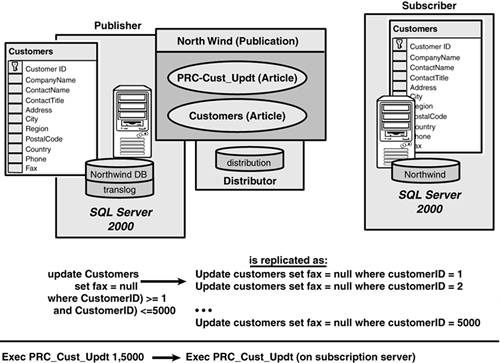The Publisher, Distributor, and Subscriber Metaphor
Any SQL Server can play up to three distinct roles in a data replication environment:
As a Publication server (the publisher of data)
As a Distribution server (the distributor of data)
And, as a Subscription server (the subscriber to the data being published)
The publication server contains the database or databases that are going to be published. This is the source of the data that is to be replicated to other servers. In Figure 7.4, the Customers table in the Northwind database is the data to be published. To publish data, the database that contains the data must first be “enabled” for publishing. Full publishing configuration requirements will be discussed later in this chapter in the “Setting Up Replication” section.
The distribution server (distributor) can either be on the same server as the publication server or on a different server—in this case, a remote distribution server. This server will contain the distribution database. This database, also called the store-and-forward database, holds all the data changes that are to be forwarded from the published database to any subscription servers that subscribe to the data. A single distribution server can support several publication servers. The distribution server is truly the workhorse of data replication.
The subscription server contains a copy of the database or portions of the database that are being published. The distribution server sends any changes made to a table in a published database to the subscription server's copy of that table. There can be one or more subscribers. SQL Server 2000 also supports heterogeneous subscribers. Pretty much any ODBC or OLE compliant database (such as Oracle) can be a subscriber to data replication.
In early days of SQL Server, data replication would only send the data to the subscription server and then the data would be treated as read-only. In SQL Server 2000, subscribers can make updates, which are then returned to the publisher—known as the updating subscriber. It is important to note that an updating subscriber is not the same as a publisher and requires a special replication configuration.
Along with these distinct server roles, Microsoft utilizes a few more metaphors. These are publications and articles. A publication is a group of one or more articles, and is the basic unit of data replication. An article is simply a pointer to a single table, or a subset of rows or columns out of a table, that will be made available for replication.
Publications and Articles
A single database can contain more than one publication. You can publish data from tables, database objects, the execution of stored procedures, and even schema objects, such as referential integrity constraints, clustered indexes, non-clustered indexes, user triggers, extended properties, and collation. Regardless of what you plan to replicate, all articles in a publication are synchronized at the same time. Figure 7.5 depicts a typical publication with two articles. You can choose to replicate whole tables, or just parts of tables via filtering.
Filtering Articles
You can create articles on SQL Server in several different ways. The basic way to create an article is to publish all of the columns and rows that are contained in a table. Although this is the easiest way to create articles, your business needs might require that you publish only certain columns or rows out of a table. This is referred to as filtering vertically or horizontally. Vertical filtering filters only specific columns, whereas horizontal filtering filters only specific rows. In addition, SQL Server 2000 provides the added functionality of join filters and dynamic filters. We discuss filtering here because depending on what type of high availability requirements you have, you may need to employ one or more of these techniques within data replication.
As you can see in Figure 7.6, you might only need to replicate a customer's customer ID, company name, and phone number to various subscribing servers around your company (vertical filtering). For this application, the Address data is restricted information and should not be replicated. You can create an article for data replication which contains a subset of the Customers table that will be replicated to these other locations.
Figure 7.6. Vertical filtering is the process of creating a subset of columns from a table to be replicated to subscribers.

In another example, you might need to publish only the Customers table data that is in a specific region, requiring you to geographically partition the data. This process, as shown in Figure 7.7, is known as horizontal filtering.
Figure 7.7. Horizontal filtering is the process of creating a subset of rows from a table to be replicated to subscribers.
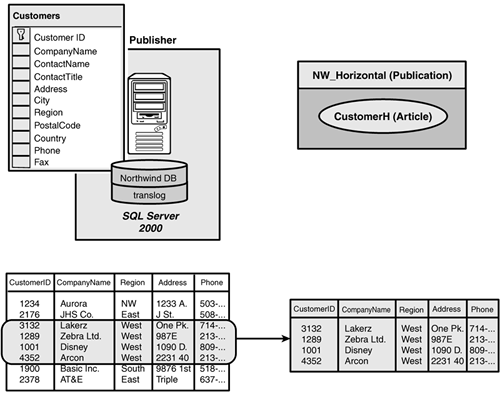
It is possible for you to combine both horizontal and vertical filtering, as shown in Figure 7.8. This allows you to pare out unneeded columns and rows that aren't required for replication. In our example, we might only need the “west” Region data and only require CustomerID and CompanyName data to be published.
Figure 7.8. Combining horizontal and vertical filtering allows you to pare down the information in an article to only the important information.
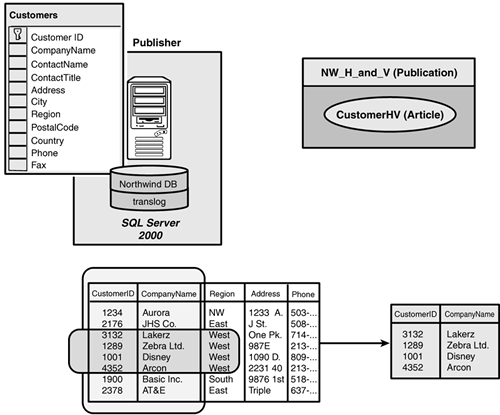
As mentioned earlier, it is now possible for you to have join filters. Join filters enable you to go one step further for a particular filter created on a table to another. In other words, if you are publishing the Customers table data based on the Region (west), you can extend filtering to the Orders and Order Details tables for the west region customers orders only, as shown in Figure 7.9. This way, you will only be replicating orders for customers in the west to a location that only needs to see that specific data. This can be very efficient if it is done well.
You also can publish “stored procedure executions” as articles, along with their parameters. This can be either a standard procedure execution article or a serializable procedure execution article. The difference is that the latter is executed as a serializable transaction and the other is not. A serializable transaction is a transaction that is being executed with the serializable isolation level, which will place a range lock on the affected data set, preventing other users from updating or inserting rows into the data set until the transaction is complete.
What publishing stored procedure executions as articles buys you is a major reduction of mass SQL statements being replicated across your network. For instance, if you wanted to update the Customers table for every customer between customerID = 1 and customerID = 5000, the Customers table updates would be replicated as a large multi-step transaction involving 5,000 separate update statements. This would significantly bog down your network. However, with stored procedure execution articles, only the execution of the stored procedure is replicated to the subscription server, and the stored procedure is executed on that subscription server. Figure 7.10 illustrates the difference in execution described earlier. Some subtleties when utilizing this type of data replication processing can't be overlooked, such as making sure that the published stored procedure behaves the same on the subscribing server side. Just to be safe, you should have abbreviated testing scripts that can be run on the subscriber whose results will be verified with the same results on the publisher.
Now, it is essential to learn about the different types of replication scenarios that can be built, and the reasons why any one of these would be desired over the other. It also is worth noting that Microsoft SQL Server 2000 supports replication to and from many different “heterogeneous” data sources. In other words, OLE DB or ODBC data sources can subscribe to SQL Server publications, as well as publish data. This includes a number of data sources, including Microsoft Exchange, Microsoft Access, Oracle, and DB2.


